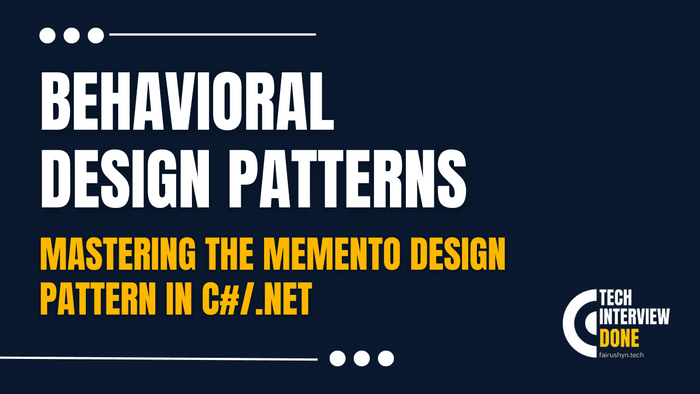Mastering the Memento Design Pattern in C#/.NET
A Guide for Advanced Developers
3 min read · — #design-patterns#structrural-patterns#memento
Introduction
In the ever-evolving landscape of software development, the ability to revert to a previous state or undo operations is not just a luxury—it's often a necessity. Whether it's the simple act of pressing "Ctrl + Z" in a text editor, or more complex scenarios like rolling back transactions in a database, the underlying principle remains the same: preserving state for potential restoration. This is where the Memento Design Pattern shines, offering a sophisticated yet elegant solution. Aimed at developers who seek to deepen their design pattern arsenal, this post will dissect the Memento Pattern, showcasing its relevance and application in the modern .NET ecosystem.
The Essence of the Memento Pattern
At its core, the Memento Pattern is a behavioral design pattern that allows an object to save its state to revert to that state at a later point, all without revealing the details of its implementation. This pattern is particularly useful in applications where state restoration is critical, such as editors, games, or any complex transactional system where undo functionality can be a game-changer.
Components of the Memento Pattern
- Originator: The object whose state needs to be saved and restored.
- Memento: A lightweight object that stores the state of the Originator. It's a snapshot of the Originator's state at a given time.
- Caretaker: Manages the Memento(s). It records, stores, and requests Mementos from the Originator but does not modify or inspect them directly.
Implementing the Memento Pattern in C#/.NET
Let's consider a real-world scenario: a document editor. This editor allows users to type text, format it, and importantly, undo any changes if they make a mistake. Here's how we can implement the Memento Pattern to achieve this functionality:
The Memento
public class EditorState
{
public string Content { get; private set; }
public EditorState(string content)
{
Content = content;
}
}The Originator
public class Editor
{
public string Content { get; set; }
public EditorState CreateState()
{
return new EditorState(Content);
}
public void RestoreState(EditorState state)
{
Content = state.Content;
}
}The Caretaker
public class History
{
private Stack<EditorState> states = new Stack<EditorState>();
public void SaveState(EditorState state)
{
states.Push(state);
}
public EditorState RestoreState()
{
if (states.Count > 0)
return states.Pop();
return null;
}
}Putting It All Together
class Program
{
static void Main(string[] args)
{
var editor = new Editor();
var history = new History();
editor.Content = "This is the first sentence.";
history.SaveState(editor.CreateState());
editor.Content = "This is the second sentence.";
history.SaveState(editor.CreateState());
// Undo the last change
editor.RestoreState(history.RestoreState());
Console.WriteLine(editor.Content); // Output: This is the first sentence.
// Undo again
editor.RestoreState(history.RestoreState());
Console.WriteLine(editor.Content); // Output: Initial state or empty if no previous state exists
}
}Real-World Applications
The Memento Pattern's applications extend beyond text editors. Consider its use in:
- Game Development: Saving game states at specific points to allow players to return to them.
- Financial Systems: Implementing transactional systems where operations can be rolled back.
- Software Version Control: Capturing the state of code at various points in time, allowing developers to revert to previous versions.
Conclusion
The Memento Design Pattern offers a robust solution for managing state in complex applications. By understanding and implementing this pattern, developers can ensure that their applications are resilient, user-friendly, and maintain a high level of integrity in state management. Whether you're building a simple application or a complex system, the principles of the Memento Pattern can significantly enhance your software's functionality and reliability. Embrace the pattern, and watch your projects transform with the newfound ability to gracefully handle state restoration.
